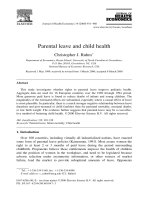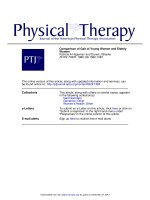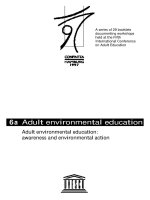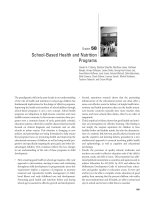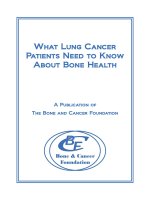Asthma Coloring and Activity Book pdf
Bạn đang xem bản rút gọn của tài liệu. Xem và tải ngay bản đầy đủ của tài liệu tại đây (2.97 MB, 44 trang )
Coloring and
Activity Book
Asthma
©Advocate Health Care
2025 Windsor Drive, Oak Brook, IL 60523
This patient guide was partially funded by a grant
from Merck & Co. Inc. and the Otho S.A. Sprague
Memorial Institute.
1
Breathing can be okay.
Your asthma can be well controlled. This coloring and activity book is for
children and their families. Each activity will take you step by step to
understanding how to be your best with asthma. It will tell about asthma
and the plan created by you and your doctor. There are pages to color,
pictures to draw, things to figure out and puzzles to do.
What is asthma?
Color the Lungs:
2
Asthma takes place in the
breathing tubes in your lungs
(your airways).
There are two kinds of asthma.
Intermittent asthma is when symptoms
come and go. Sometimes the signs or
symptoms seem to be brought about
by very specific things like exercise.
The second kind of asthma is called
persistent asthma. This means that the
problem is always there. When your
asthma is in good control because you
are taking your daily medicines you
may not have symptoms.
You work with your doctor to make an ASTHMA
ACTION PLAN. This plan is made for each
person because asthma can be different in every
person with asthma. People with asthma can lead
active, busy lives full of fun activities.
11
22
3
What are the STATS or numbers about
asthma?
• 18 million people in the United States have asthma.
• More children have asthma than any other ongoing (chronic) disease.
• 5 million American children have asthma.
• The number of people who are dying from asthma is going up.
• Asthma is expensive for the United States. Missed work and school due
to asthma, asthma medicines and hospital visits for asthma cost
$6,000,000,000.
— One visit to the emergency room can cost almost $2,000.
Draw 6 billion dollars. (That’s a lotta moola!)
4
Breathing, How the lungs work:
Breathing in and out should be easy. Air travels from the nose and the
mouth then to airways in the lungs. The air in the lungs carries oxygen to
feed the body. Air also carried carbon dioxide (CO
2
) out of the lungs.
CO
2
is a waste product and needs to come out of the body.
O
2
/CO
2
MAZE
Out with the bad air in with the good…start
at the “X” and find your way.
O
2
CO
2
X
5
Airways in asthma
People with asthma have airways that are sensitive or twitchy. The
sensitive airways are worse when they come in contact with certain things
called triggers. Some triggers are cold air, animal fur, and dust or tree
and plant pollen. Viruses make people sick with a cold can also be a
trigger for asthma. Triggers can make the airways swell and become
narrow. When this is really bad it is called an asthma attack. Many people
with asthma have a family member with asthma or allergies.
Hidden Picture of Triggers
Can you find all of the triggers that appear in these pictures?
6
Asthma Attacks
During an asthma attack the airways become narrowed from:
• Increased swelling
• Tightening of the muscles around the airways
• Mucous or phlegm
As the airways swell up, the muscles on the outside of the airways
tighten, causing them to narrow. When they narrow, air cannot move
through the airways and it becomes hard to breathe air in and out. The
lungs make more thick, gooey mucous that blocks the airways. In an
asthma attack you may cough constantly, start wheezing or feel that it is
hard to breathe.
Color the three different airways and circle
the one that is best!!
7
Asthma attacks can be different for each person.
Not everyone has a cough or wheeze.
How do you know if you or
someone in your family has asthma?
The following are signs and symptoms of asthma.
Color the squares of any of the signs below you have
or had when you first found out you had asthma
❑ Wheezing or whistling sound
❑ Constant Cough
❑ Chest hurts or feels tight
❑ Throat hurts or is itchy
❑ Nose itchy
❑ Trouble breathing during and after exercise
and/or being very tired
❑ Fast breathing
❑ Scared feeling
❑ Heaviness or pressure in or on chest
❑ Nighttime breathing problem that wakes
you up
8
The following are some of the signs of an asthma
attack
• Nose flaring
• Tightness in the chest
• Coughing or wheezing
• Not being able to sleep due to constant
coughing or waking up often at night
• Difficulty breathing
• Fast breathing
• Peak flow meter reading in the yellow or
red zone (more about this on page X)
DANGEROUS SIGNS
• PALE OR BLUE LIPS OR FINGERS
• BELLY OR CHEST LOOKS SUNKEN
CALL 911 WITH DANGER SIGNS
9
ACTIVITY: How it looks when I’m having an
asthma attack.
My warning signs Draw a picture of yourself HERE
10
Triggers: Can you name them?
Triggers cause asthma symptoms and may lead to an attack. There are
ways to control and reduce most triggers.
ANIMALS
Cat and Dog fur and dander are triggers.
Draw your dog or cat (real or imaginary):
It’s better not to own a cat or dog but if you have one and aren’t able to
give it a new home then…
• Keep them outside. Or, at least out of your bedroom.
• Make sure someone cleans ups, sweeps, and vacuums up all
pet hair.
• Have someone clean kitty litter daily.
11
DUST MITES
Draw what you think a dust mite looks like.
• Wash sheets, pillowcases and bedspreads weekly in hot water
(warm water will not kill dust mites).
• Do not keep real houseplants.
• Keep plastic covers on mattresses and pillows (where to buy
them on page 40).
• Keep carpets steam cleaned but bare floors are even better.
COCKROACHES
Color in the cockroach.
• Don’t have food outside of the kitchen and eat only at the table.
• Cover cracks and crevices with steel wool, caulk and caulk gum.
• Use roach motels or gel bait. (Don’t use sprays.)
12
MOLD
There’s a fungus among us (say it three times fast!)
• Change furnace filters monthly.
• Keep only one stuffed animal in your bedroom.
• Keep rooms dry (tell mom or dad <40% humidity)
• Don’t use a humidifier in your home.
SMOKING
DRAW THE NUMBER OF KISSES YOU WOULD GIVE SOMEONE WHO
QUIT SMOKING FOR YOU. (PLACE THEM ANYWHERE ON THIS
PAGE)
• Stay away from cigarette smoke.
• Ask people to smoke outside.
• Ask family and friends to try to quit smoking.
• Smokers should never smoke in the house.
• Smokers should not smoke in rooms that you
use even if you are not there.
13
STRONG ODORS
• Use hypoallergenic perfumes and make-up.
• Use odor free shampoo, soap, laundry detergents
and lotions.
• Don’t use baby powder.
• Don’t use dryer sheets or liquid fabric softeners.
• Use a clothes dryer do not hang clothes outside they
will pick up pollen.
Color by number
1=RED 2=BLUE 3=GREEN 4=YELLOW 5=ORANGE 6=BROWN 7=BLACK
1
2
2
2
3
4
6
6
6
6
5
5
7
7
4
14
POLLUTION
Draw a stream of smoke from what you think makes the most pollution
by your home.
• Smoke, dirt and vapors are in the air. Factories and cars
and trucks put them there.
• Avoid places with a lot of pollution.
• Watch or listen to the news. Know the pollution conditions
like ozone warnings daily. Stay inside when the numbers
are up. Call (312) 744-4365 to check ozone levels.
• Clean air filters on furnaces and air conditioners.
15
POLLEN
Color and draw these
pollen makers.
March through June - tree make the pollen.
May through June - grass is the bandit.
August through the first frost - weeds make their pollen.
If you play outside, take a shower and wash your hair to get the
pollen off especially before going to bed.
COLD AIR
Put a scarf on the girls face.
Breathing cold air can cause an attack. Use a scarf or mask over your
nose and mouth in very cold weather. Or you can pull your turtleneck up
over your nose and mouth.
16
INFECTIONS
Draw and color a virus.
• Colds and flu are caused by viruses and can
make asthma worse.
• Avoid getting or spreading viruses by washing
your hands.
• Eat healthy foods, including five servings of
fruits and vegetables a day.
• Drink plenty of water, juice, Kool aid or
Gatorade.
5-6 glasses a day. Don’t drink pop.
• Get a flu shot from your doctor every year in
the fall.
Wash hands when dirty, after play, before
meals, after petting animals.
17
ACTIVITY: Know your triggers, tiggr and
make a plan, man
Name that
trigger
Plan to stop
that trigger
Great stuff to
buy or borrow
that can really
help
What-ja do?
18
EMOTIONS
When you start to feel stressed or angry try these exercises and see what
works best for you.
1. Take a deep breath in through your nose and out through your
mouth. (Purse your lips like a big kiss.)
2. Talk with an adult.
3. Try counting to 10.
4. Try the activity found below.
5. It’s normal to feel scared or upset when you are having trouble
with your breathing. Start by trying your best to go slow and
“take it easy”
What color is like when you are
Mind and body calming exercise
In the space below draw a place that you find very relaxing (the beach,
the mountains, your favorite chair)
SAD?
MAD?
GLAD?
BAD?
19
Find a place that you feel safe and comfortable.
Now go to the place that you find calming by
picturing it in your mind.
Take those deep breaths IN and OUT
Make your whole body relaxed like JELLO.
Tighten and then let it go. Start with your head and
move down to each part of your body until you get
to your toes.
Count slowly as high as you can go.
Slow your breathing down with each number.
Now really imagine what it feels like at that special
place.
Is it the breeze in your hair?
Is it the warmth on your neck?
Is it the sand between your toes?
Is it the beautiful colors?
It’s okay to sit alone, in someone’s lap or with a
friend.
20
Exercise Asthma
Exercise asthma can occur during exercise or playing sports. Having this
type of asthma does not mean you cannot exercise! Remember many
popular athletes have asthma. If you have exercise asthma the best thing
to do is take your medicine before exercise, recess, sports or play.
• Take your rescue medicines 20-30 minutes before you
play sports.
• Try keeping a journal of what type of activity makes you feel
wheezy or tight. Then make sure to take your medicine
before these activities.
21
ACTIVITY JOURNAL
(plan this with your doctor)
ACTIVITIES THAT MAKE ME FEEL WHEEZY OR TIGHT
ACTIVITIES THAT I LIKE TO DO
I SHOULD TAKE MY RESCUE INHALER (SPRAY)
_______ MINUTES BEFORE ACTIVITY
QUESTIONS FOR MY DOCTOR
1.
2.
3.
4.
5.
6.
7.
8.
22
Q: What is a peak flow meter?
A peak flow meter is a device that measures how well your asthma is doing.
It can be very helpful in warning you early, before you feel symptoms.
What a peak flow meter can tell you:
• help you monitor your asthma action plan.
• when to call you doctor.
• when to go to the clinic or emergency room.
1=RED
2=YELLOW
3=GREEN
4=PINK
5=BLUE
1
2
3
4
3
3
3
5
5
5
23
How to use a peak flow meter
1. Move the indicator to the bottom of the scale.
2. Stand up.
3. Take a deep breath.
4. Place the mouthpiece in your mouth, close your lips around it. Don’t
put your tongue inside the hole.
5. Blow once as hard and fast as you can.
6. Follow steps 1-5 three times. Record the highest number reached in
your peak flow diary (see page 36). This number is your personal best
and helps you know your personal zones.
Follow steps 1-6 in the morning and in the evening, everyday at the same
time or as your doctor tells you.

